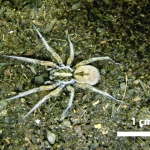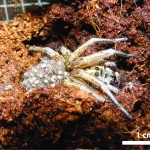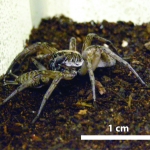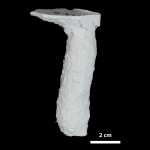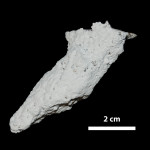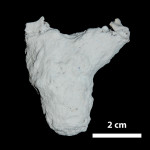Wolf Spider (Hogna lenta)
For full details see Hils and Hembree (2015) in Palaeontologia Electronica.
Description of Organism
- Araneomorph spider of the family Lycosidae.
- Araneomorph spiders are slender, weave webs, and have transversely crossing chelicerae.
- Primarily found in environments with sandy sediments in the southeastern United States.
- Nocturnal active hunters that use burrows as shelters during the day.
- After reaching adulthood, the wolf spider only lives for up to one year.
Published Descriptions of Organism
Hils and Hembree (2015):
- Hogna lenta (formerly Lycosa lenta) belongs to the araneomorph family Lycosidae, which has a fossil record extending to the Cretaceous. Members of this family are active hunters that use their burrows as a daytime retreat. Hogna lenta is native to the southeastern portion of the United States, particularly Florida. They occupy a variety of habitats although they are often found in sandy sediments. These spiders are nocturnal and emerge from their burrows at dusk to search for prey. Hogna lenta lives for up to one year upon reaching adulthood. The burrows produced by H. lenta are generally simple, vertical shafts that may have a turret. The burrows are sealed with a trapdoor constructed of a thick layer of silk covered by sand or other material.
Burrowing Technique
Hogna lenta burrows by compressing the sediment against the walls of their burrow using their walking legs, pedipalps, and chelicerae. A thin layer of silk is deposited along the sides of the burrow as the spider moves into the sediment. Hogna lenta covers its burrows with a thin layer of sediment held together with silk.
Burrowing Technique Videos
Burrowing Behavior
Hogna lenta burrowed 0-15 days after being placed in the enclosure. Most individuals that burrowed did so within five days although many individuals did not burrow at all. In general, smaller individuals of H. lenta burrowed faster and more frequently than larger ones. Burrows were used for dwelling, hunting,and nesting. Wolf spiders are often at the surface, but typically retreat into their burrow in response to bright light and disturbances near their enclosures. Although H. lenta is an active surface hunter, some individuals ambush their prey from their burrow entrances. Nesting burrows are enlarged to house the spider and egg sack; spiders with egg sacks rarely left their burrows to hunt.
Trace Morphology
Hogna lenta produces three distinct burrow architectures: vertical shafts, subvertical ramps, and Y-shaped burrows; examples of each are shown below. Each photo is linked to an information page about the specific architecture.
Click here for the complete photographic archive of all burrows produced by Hogna lenta.
